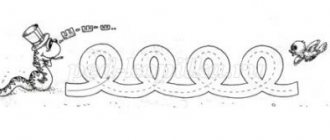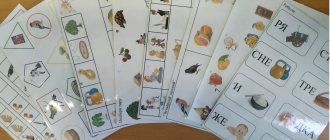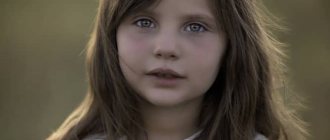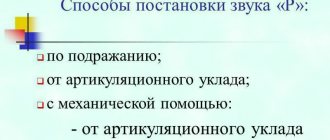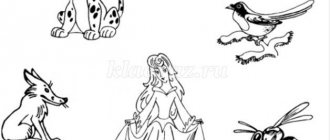Automation of the sound [С] in sentences of 4 words:
- There are a lot of wasps in the garden.
- Sonya eats the soup herself.
- Anfisa drinks plum juice.
- There is a bus on the bridge.
- The dog eats a piece of meat.
- Sanya is preparing soup for pussy.
- Bushes were planted in the garden.
- The bench is in the garden.
- Sonya took off her boots herself.
- An owl sits on a branch.
- Sanya rides a scooter.
- Sonya has a beautiful bag.
Automation of the sound [S] in 3-word sentences:
- There are wasps in the garden.
- The catfish has a mustache.
- The son is eating soup.
- The shepherd was tending the flock.
- Denis drinks kumiss.
- The son is washing the dishes.
- Sanya washes the dishes.
- Sonya eats a cupcake.
- Denis drinks juice.
- The sun is shining clear.
- Sonya heard a knock.
- The plane is flying high.
- The dump truck spilled sand.
- The wasp bit Sonya.
- Sanya got a flat tire.
- Pussy eats meat.
Development of articulatory motor skills
L: Let's work on our tongue. Once upon a time there lived a kind and cheerful tongue. Let's say hello to the tongue. Show me your tongue. First long, and then short. Now move it quickly (demonstration: open your mouth, extend your tongue and move up, down, left, right). We decided to play football with him; to score a goal, you need to drive the ball into the goal.
Pull your lips forward with a tube and blow on the ball until the child pushes it between the cubes. After football, Tongue got hungry and decided to make pancakes. For pancakes we will knead the dough. Smile. Open your mouth slightly. Slap your tongue between your lips - “pa- pa- pa- pa- pa...”. Hold in a calm position while counting from 1 to 5. Now let’s make pancakes. Smile and open your mouth slightly.
Place your wide tongue on your lower lip (hold for a count of 5 to 10 seconds). The pancake turned out to be hot, let's blow: ssss!!!! We ate pancakes, now let’s brush our teeth (smile, show your teeth, and alternately “brush” the lower and upper teeth with the tip of your tongue). R: Performs the exercise, we monitor the static coordination of movements.
Automation of sound [C] in sentences of 7 - 8 words:
- Sanya has pineapple and cabbage in her bag.
- Savva has a ficus, and Sonya has a cactus.
- Sonya and Sanya go to a dog show.
- Sanya has a catfish with a mustache in the jar.
- In our garden there are bushes and tall pines.
Visualization of automating the sound “C” in phrases and sentences will be a good help in your lessons with children.
Automation of the sound [S] in 5-word sentences:
- There is a tall pine tree in the garden.
- The dog Jay stands under the pine tree.
- Sonya has a waist-length braid.
- Sonya puts her bag on the bench.
- Sanya's sled glides on its own.
- Owls are sitting on a pine branch.
- Stas and Sonya go to the garden.
- There is a hanging bridge near the high rock.
- An empty bus is driving across the bridge.
- Anfisa prepares a delicious soup herself.
Automation of sound [С] in phrases:
- Tasty soup ; _ _ whiskered catfish; tall pine; suspension bridge; pine branch; dry scarf; mother's beads; soft wax; high cliff; sleepy pussy; honeycomb; clear day; a skilled magician; dangerous ledge; butter dough; morocco boots; empty bowl; thick juice; shady garden; Pineapple juice; satin belt; empty bus; hearty jelly; meat sauce; bus stop; thin cloth; Empty room; baby carriage.
Work on the syllabic structure of a word, sound analysis of syllables
L: Artem, look, I have a picture in my hands, what is drawn in this picture? Our bear Styopa loves sledding. How many syllables are in the word "sleigh"? Say the word “sleigh in syllables.” Get your hands ready, let's try to pronounce this word together: - San (clap) - ki (clap) How many syllables are in the word sani? Two. Now look, there are red, blue and green chips in front of you. Let's put the word Sankey out of these chips. • The red chip is a vowel sound. • The blue chip is a consonant sound. • The green chip is a soft consonant sound. — The first syllable in the word Sanki is San. Lay out this syllable using our chips. R: puts the red chip first, green chip second, blue chip third. L: No. Artem, let's try together to determine what chips the word Sanki consists of. — Explains to the child which chip should go behind which and why. • 1 blue chip, because the sound [s] is a consonant and a hard sound, • 2 red chip, because the sound [a] is a vowel, • 3 blue chip, because the sound [n] is a consonant and a hard sound. L: The second syllable in the word Sanki is Ki. What is the sound [k']? - Well done! What else? R: consonant, hard, voiced! L: Let's say together: - K, K, K! - The sound of K is soft, now put your hand to your throat and say again - K, K, K! - Do you feel the vibration? - So the sound [кь] is what R: k- k- k- k- k. Deaf. L: What color do we designate it with? Since he is agreeable and soft? R: Green! L: Correct, what is the sound? What color do we use to represent it? R: Vowel, red! L: Right, now try to spell out the syllable Ki with chips. R: • 1 chip is green, because the sound [k'] is consonant and soft, • 2 chip is red, because the sound [i] is a vowel. L: Well done, that's right!
Homework
L: Artem, Styopa asks you to cut out beautiful snowflakes from paper at home and decorate the house with them.
Bottom line
L: Today the bear Styopa found a new friend, he really liked playing with you. What sound does Styopa's name begin with? R: From the sound [s]! L: Right! What is the sound [s]? R: consonant, hard, deaf!
Performance evaluation
L: Well done. Styopa really enjoyed playing with you, but it’s time for him to go home to his forest friends. He says goodbye to you. You can go too! R: Goodbye!
Related posts:
- What is "War and Peace" about? Summary of the novel “War and Peace” by chapters. All answers...
- P.P. Ershov “The Little Humpbacked Horse” - summary of “The Little Humpbacked Horse” by P.P. Ershov - a very brief summary for the reader...
- I.S. Turgenev “Mumu” “Mumu” I.S. Turgenev: read the story ONLINE without registration. The work in its entirety...
- What do we know about Morse code? Morse code was created to transmit short information. But use...
Development of visual perception and fine motor skills
L: Let's play a game called "Which picture is missing?" — There are pictures in front of you: Snowman, Sledge, Elephant, Table. - Remember these pictures. When you remember them, “night” will begin and you will close your eyes. - When I say “day”, you will have to open your eyes and say which of the pictures is gone. - “Night” (The speech therapist removes the picture with the snowman). - "Day". Open your eyes. -What picture is missing? - The snowman is missing! (The speech therapist puts the picture of the snowman with the other pictures) - Try to remember all the pictures again: Snowman, Sleigh, Elephant, Table - “Night” (The speech therapist removes the picture with the elephant). - "Day". What picture is missing? - Right! (The speech therapist puts a picture of an elephant with the other pictures). R: Answers, completes the task, if he makes a mistake, the speech therapist helps.
Development of phonemic processes
L: Now let's play the game "Recognize the sound." There are different objects in front of you: a spoon, a glass, paper. Now I will show you how sound is produced by each object, and you remember this. The speech therapist taps the glass with a spoon, then rustles the paper. - Now close your eyes, I will make sounds, and then you will show me what object I used to make this sound. The speech therapist knocks a spoon on a glass and rustles paper. Plays sounds again so that the child remembers them. R: closes his eyes and then recognizes sounds; if there are mistakes or difficulties, the speech therapist helps.
Development of visuospatial orientation
L: Now let’s go to the table (they get up and go to another table that was prepared in advance). Look at our table. There are various objects on it. There is a bowl to your right, take it and give it to me. R: At first he reaches out to the elephant, but then he takes the bowl and gives it to the speech therapist L: That's right! There is an elephant (toy) to your left, take it and give it to me. R: takes the elephant and gives it to the speech therapist. L: Right! (removes the elephant and the bowl, takes out toy boots and socks). Take the object that lies closer to you and give it to me (the boots are closer). And then take the object that is further from you (further are the socks) R: Takes the socks and gives them to the speech therapist. Afterwards he corrects himself and takes the boots, and then takes the socks and also gives them to the speech therapist. L: Well done!!
